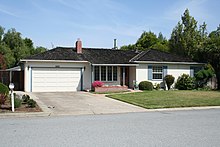In 1974, Jobs took a job as a technician at Atari, Inc. in Los Gatos, California.[22] He traveled to India in mid-1974[23] to visit Neem Karoli Baba[24] at his Kainchi Ashram with a Reed College friend (and, later, an early Apple employee), Daniel Kottke, in search of spiritual enlightenment. When they got to the Neem Karoli ashram, it was almost deserted as Neem Karoli Baba had died in September 1973.[22] Then they made a long trek up a dry riverbed to an ashram of Hariakhan Baba. In India, they spent a lot of time on bus rides from Delhi to Uttar Pradesh and back, then up to Himachal Pradesh and back.[22]
Jobs left India after staying for seven months[25] and returned to the US ahead of Daniel Kottke,[22] with his head shaved and wearing traditional Indian clothing.[26][27] During this time, Jobs experimented with psychedelics, calling his LSD experiences "one of the two or three most important things [he had] done in [his] life".[28] He also became a serious practitioner of Zen Buddhism, engaged in lengthy meditation retreats at the Tassajara Zen Mountain Center, the oldest Sōtō Zen monastery in the US,[29] considered taking up monastic residence, and maintained a lifelong appreciation for Zen.[30] He later said that people around him who did not share his countercultural roots could not fully relate to his thinking.[28]
Jobs returned to Atari and was assigned to create a circuit board for the game Breakout. According to Atari co-founder Nolan Bushnell, Atari offered $100 for each chip that was eliminated in the machine. Jobs had little interest in or knowledge of circuit board design and made a deal with Wozniak to split the fee evenly between them if Wozniak could minimize the number of chips. Much to the amazement of Atari, Wozniak reduced the number of chips by 50, a design so tight that it was impossible to reproduce on an assembly line. According to Wozniak, Jobs told Wozniak that Atari gave them only $700 (instead of the offered $5,000) and that Wozniak's share was thus $350.[31] Wozniak did not learn about the bonus until ten years later, but said that had Jobs told him about it and said he needed the money, Wozniak would have given it to him.[32]
Jobs began attending meetings of the Homebrew Computer Club with Wozniak in 1975.[2] He greatly admired Edwin H. Land, the inventor of instant photography and founder of Polaroid Corporation, and explicitly modeled his own career after that of Land's.[33][34]
Apple Computer
See also: History of Apple

Home of Paul and Clara Jobs, on Crist Drive in Los Altos, California. Steve Jobs formed Apple Computer in its garage with Steve Wozniak and Ronald Wayne in 1976. Wayne stayed only a short time, leaving Jobs and Wozniak as the primary co-founders of the company.
In 1978, Apple recruited Mike Scott from National Semiconductor to serve as CEO for what turned out to be several turbulent years. In 1983, Jobs lured John Sculley away from Pepsi-Cola to serve as Apple's CEO, asking, "Do you want to sell sugar water for the rest of your life, or do you want to come with me and change the world?"[37]
In the early 1980s, Jobs was among the first to see the commercial potential of Xerox PARC's mouse-driven graphical user interface, which led to the creation of the Apple Lisa. One year later, Apple employee Jef Raskin invented the Macintosh.[38][39]
The following year, Apple aired a Super Bowl television commercial titled "1984". At Apple's annual shareholders meeting on January 24, 1984, an emotional Jobs introduced the Macintosh to a wildly enthusiastic audience; Andy Hertzfeld described the scene as "pandemonium".[40]
While Jobs was a persuasive and charismatic director for Apple, some of his employees from that time described him as an erratic and temperamental manager. An industry-wide sales slump towards the end of 1984 caused a deterioration in Jobs's working relationship with Sculley, as well as layoffs and disappointing sales performance. An internal power struggle developed between Jobs and Sculley.[41] Jobs kept meetings running past midnight, sent out lengthy faxes, then called new meetings at 7:00 am.[42]
Sculley learned that Jobs—believing Sculley to be "bad for Apple" and the wrong person to lead the company—had been attempting to organize a boardroom coup, and on May 24, 1985, called a board meeting to resolve the matter.[41] Apple's board of directors sided with Sculley and removed Jobs from his managerial duties as head of the Macintosh division.[43][44] Jobs resigned from Apple five months later[41] and founded NeXT Inc. the same year.[42][45]
In a speech Jobs gave at Stanford University in 2005, he said being fired from Apple was the best thing that could have happened to him; "The heaviness of being successful was replaced by the lightness of being a beginner again, less sure about everything. It freed me to enter one of the most creative periods of my life." And he added, "I'm pretty sure none of this would have happened if I hadn't been fired from Apple. It was awful-tasting medicine, but I guess the patient needed it."[21][46][47]
No comments:
Post a Comment